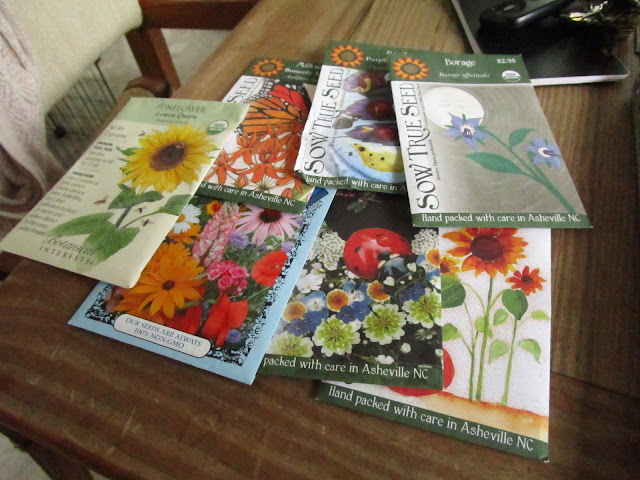Seed Saving - For Beginners
Hi All,
Hope your garden is growing well. It's the end of the summer now and I'm getting geared up for the fall.
Today, I wanted to write a quick overview on seed saving including information on the easiest seeds to save, some tips on how to collect seeds, and best ways to store them.
So today we are going to talk about saving actual seeds. Not all plants are grown from seeds in the traditional sense (hello garlic bulbs and "seed" potatoes) so this post is not necessarily conclusive. Remember, I am a beginner after all.
Stickier seeds, like tomatoes, do not do well on paper towels or plates and glass or perhaps a parchment paper would be a better choice. Additionally, tomato seeds require fermentation to break down the coating on the outside of the seed. Because I am a beginner, I have not tried this fermentation process.
My process for simpler seeds like beans and peas is more or less this:
1. Harvest the seed pod and allow pods to dry on paper plates labeled with the type of seed.
2. Once the pods are somewhat dried, I remove the seeds from the pods and allow to dry again. During each step I try to keep seed separated from other plant debris.
3. Rotate seeds around every so often until they are completely dried. Fully dried seeds are then ready to store. Into seed packets or zip bags they go!
Well, there is my brief overview on seed saving. I'd say this is more of an intermediate gardener's practice. If you are new to gardening, I would skip this for a while and focus more on getting the timing of planting and care of a garden down.
Take care,
Rebecca
Hope your garden is growing well. It's the end of the summer now and I'm getting geared up for the fall.
Today, I wanted to write a quick overview on seed saving including information on the easiest seeds to save, some tips on how to collect seeds, and best ways to store them.
So today we are going to talk about saving actual seeds. Not all plants are grown from seeds in the traditional sense (hello garlic bulbs and "seed" potatoes) so this post is not necessarily conclusive. Remember, I am a beginner after all.
Why Save Seeds?
Well, one of the biggest reasons to save seeds is because it can save a gardener money. Buying transplants are expensive year after year and even though seed packets are cheaper sometimes they don't feel like money well spent. Saving seeds also allows a gardener ready access to a variety of plant they like. Imagine, if you will, that a seed company stops producing your favorite type of carrot seed. Now what to do? Saving your own seed eliminates that issue. Lastly, careful seed saving yields better plants. Imagine only planting seeds you know will do well in your area and grow prolifically. If you save seeds from productive plants that's what you just might get. Some people grow seeds from the save plant that their great grandfather's used! Amazing!
Easiest Seeds to Save
I would say the easiest seeds to save are those that actually look like seeds. Beans, tomatoes, peppers, peas, and lettuces tend to be easy to save. The aforementioned plants also tend to self pollinate which prevents accidental and undesirable cross breeding of plants. To imagine an unpleasant version of this, imagine a watermelon pumpkin mix. There you go. I also think chive seeds are very easy to save, too, although I am unaware of how they pollinate. It is generally recommended to only save seeds from plants that you know did not cross pollinate so they "sow true" to the original plant. Most broccoli and cabbage plants tend to cross pollinate easily so if those are grown nearby each other their seeds may not be good to save. Also, seeds from hybrid plants will not sow true. To learn more about types of seeds read my article on Reading a Seed Packet.Tips for Saving Seeds
Always allow the fruit of flower of the plant to fully ripen or bloom. Bean and pea seeds can be saved in the pod and will even start to dry on the vine. Seeds need to be removed from the fruit and placed on a paper towel type surface to dry. All seeds need to be stored in a dry, cool area until they are fully dried out.Stickier seeds, like tomatoes, do not do well on paper towels or plates and glass or perhaps a parchment paper would be a better choice. Additionally, tomato seeds require fermentation to break down the coating on the outside of the seed. Because I am a beginner, I have not tried this fermentation process.
My process for simpler seeds like beans and peas is more or less this:
1. Harvest the seed pod and allow pods to dry on paper plates labeled with the type of seed.
2. Once the pods are somewhat dried, I remove the seeds from the pods and allow to dry again. During each step I try to keep seed separated from other plant debris.
3. Rotate seeds around every so often until they are completely dried. Fully dried seeds are then ready to store. Into seed packets or zip bags they go!
Storing Saved Seeds
Once saved, store seeds in a labeled, air tight container. This is important because many varieties of seed look very similar.Well, there is my brief overview on seed saving. I'd say this is more of an intermediate gardener's practice. If you are new to gardening, I would skip this for a while and focus more on getting the timing of planting and care of a garden down.
Take care,
Rebecca


Comments
Post a Comment